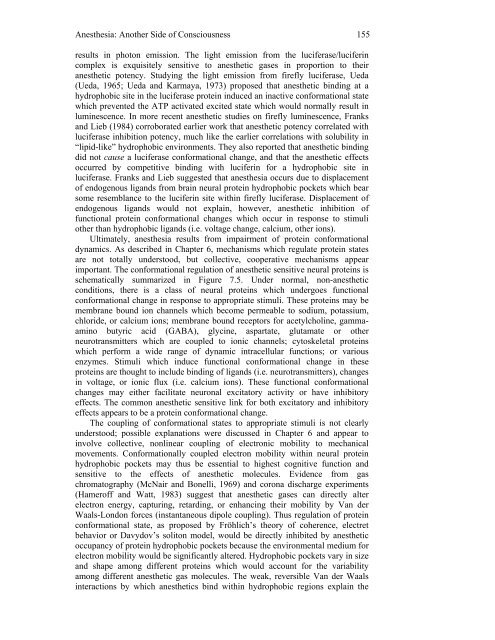ULTIMATE COMPUTING - Quantum Consciousness Studies
ULTIMATE COMPUTING - Quantum Consciousness Studies
ULTIMATE COMPUTING - Quantum Consciousness Studies
- No tags were found...
Create successful ePaper yourself
Turn your PDF publications into a flip-book with our unique Google optimized e-Paper software.
Anesthesia: Another Side of <strong>Consciousness</strong> 155<br />
results in photon emission. The light emission from the luciferase/luciferin<br />
complex is exquisitely sensitive to anesthetic gases in proportion to their<br />
anesthetic potency. Studying the light emission from firefly luciferase, Ueda<br />
(Ueda, 1965; Ueda and Karmaya, 1973) proposed that anesthetic binding at a<br />
hydrophobic site in the luciferase protein induced an inactive conformational state<br />
which prevented the ATP activated excited state which would normally result in<br />
luminescence. In more recent anesthetic studies on firefly luminescence, Franks<br />
and Lieb (1984) corroborated earlier work that anesthetic potency correlated with<br />
luciferase inhibition potency, much like the earlier correlations with solubility in<br />
“lipid-like” hydrophobic environments. They also reported that anesthetic binding<br />
did not cause a luciferase conformational change, and that the anesthetic effects<br />
occurred by competitive binding with luciferin for a hydrophobic site in<br />
luciferase. Franks and Lieb suggested that anesthesia occurs due to displacement<br />
of endogenous ligands from brain neural protein hydrophobic pockets which bear<br />
some resemblance to the luciferin site within firefly luciferase. Displacement of<br />
endogenous ligands would not explain, however, anesthetic inhibition of<br />
functional protein conformational changes which occur in response to stimuli<br />
other than hydrophobic ligands (i.e. voltage change, calcium, other ions).<br />
Ultimately, anesthesia results from impairment of protein conformational<br />
dynamics. As described in Chapter 6, mechanisms which regulate protein states<br />
are not totally understood, but collective, cooperative mechanisms appear<br />
important. The conformational regulation of anesthetic sensitive neural proteins is<br />
schematically summarized in Figure 7.5. Under normal, non-anesthetic<br />
conditions, there is a class of neural proteins which undergoes functional<br />
conformational change in response to appropriate stimuli. These proteins may be<br />
membrane bound ion channels which become permeable to sodium, potassium,<br />
chloride, or calcium ions; membrane bound receptors for acetylcholine, gammaamino<br />
butyric acid (GABA), glycine, aspartate, glutamate or other<br />
neurotransmitters which are coupled to ionic channels; cytoskeletal proteins<br />
which perform a wide range of dynamic intracellular functions; or various<br />
enzymes. Stimuli which induce functional conformational change in these<br />
proteins are thought to include binding of ligands (i.e. neurotransmitters), changes<br />
in voltage, or ionic flux (i.e. calcium ions). These functional conformational<br />
changes may either facilitate neuronal excitatory activity or have inhibitory<br />
effects. The common anesthetic sensitive link for both excitatory and inhibitory<br />
effects appears to be a protein conformational change.<br />
The coupling of conformational states to appropriate stimuli is not clearly<br />
understood; possible explanations were discussed in Chapter 6 and appear to<br />
involve collective, nonlinear coupling of electronic mobility to mechanical<br />
movements. Conformationally coupled electron mobility within neural protein<br />
hydrophobic pockets may thus be essential to highest cognitive function and<br />
sensitive to the effects of anesthetic molecules. Evidence from gas<br />
chromatography (McNair and Bonelli, 1969) and corona discharge experiments<br />
(Hameroff and Watt, 1983) suggest that anesthetic gases can directly alter<br />
electron energy, capturing, retarding, or enhancing their mobility by Van der<br />
Waals-London forces (instantaneous dipole coupling). Thus regulation of protein<br />
conformational state, as proposed by Fröhlich’s theory of coherence, electret<br />
behavior or Davydov’s soliton model, would be directly inhibited by anesthetic<br />
occupancy of protein hydrophobic pockets because the environmental medium for<br />
electron mobility would be significantly altered. Hydrophobic pockets vary in size<br />
and shape among different proteins which would account for the variability<br />
among different anesthetic gas molecules. The weak, reversible Van der Waals<br />
interactions by which anesthetics bind within hydrophobic regions explain the






